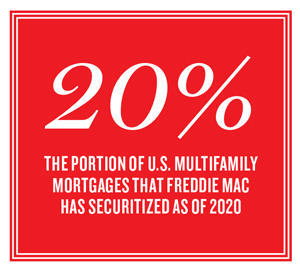Trending
How tough is Freddie when it comes to protecting landlords and tenants?

UPDATED, Oct. 21, 2020, 5:00 p.m.: Tenant protections at apartment buildings with federally backed mortgages didn’t stop landlords in Houston from trying to evict renters between March and July, when an agency-imposed ban was in place.
In a July earnings call, Freddie Mac touted its eviction moratorium at properties with loans backed by the quasi-government agency.
Nevertheless, dozens of landlords in the sprawling Gulf Coast port city filed nearly 6,000 evictions during that period, data from Harris County court records shows. That involved several properties where Freddie Mac had sponsored the debt. At one rental complex, the 60-unit Oxford Square in Independence Heights, a landlord who filed two evictions said they were justified.
“The people that we filed evictions on were the ones who purposefully did not pay anything, because they’re just playing the system,” said Thomas Yu, president of Profitway Investment Management. “Whether or not you agree with the moratorium, it’s a policy that’s kicking the can down the road.”
There’s been no lack of tension in the country’s rental markets, from Houston to Los Angeles, New York and hundreds of other cities. When Covid first pummeled property owners this spring, debt funds proliferated with plans to scoop up rental apartments just like savvy investors did during the last recession. And as unemployment reached historic levels, low-income workers were among the hardest hit, leaving many mom-and-pop landlords to fend for themselves.
At the same time, investors were becoming convinced that even multifamily properties — considered one of the safest assets in real estate due to the perpetual need for housing and overall tight supply — would soon show signs of distress.
Freddie Mac, which backs about 20 percent of the country’s $474 billion multifamily market, had other plans, however. The home loan corporation, which has been under conservatorship since the 2008 crisis, was quick to provide temporary relief, absorbing much of the sector’s exposure to the pandemic and economic upheaval.
In April, even before Congress passed its first relief program for essential workers and struggling small businesses, Freddie Mac announced a backstop for rental landlords. All mortgages backed by the government-sponsored enterprise would be eligible for a three to six-month forbearance period.
But some say that plan obscures any distress in the multifamily market as rent collections dwindle, and creates a tilted playing field.
Since the agency has no contractual ability to enforce the rule, doing so has fallen to individual tenants, courts and local jurisdictions. Many renters and borrowers were simply unaware of the protections, however, and compliance was spotty.
Of more than 4 million units financed by Freddie Mac Multifamily, the agency has received only a few dozen inquiries about potential eviction moratorium violations.
Freddie Mac’s presence in the country’s rental market has rapidly grown over the past decade, with its multifamily debt deals increasing from $15.4 billion in 2010 to $78.4 last year. One of the agency’s popular financing tools — its small balance loan (SBL) program — backs smaller, lower-income apartments where borrowers typically have less access to debt.
 In practice, however, some multifamily borrowers with institutional backing have tapped the program for larger portfolio deals by pooling the smaller loans. Those borrowers now have access to Freddie Mac’s mortgage relief program and an enviable taxpayer-backed guarantee, while those that don’t are racing to secure government-backed financing before a second virus wave hits.
In practice, however, some multifamily borrowers with institutional backing have tapped the program for larger portfolio deals by pooling the smaller loans. Those borrowers now have access to Freddie Mac’s mortgage relief program and an enviable taxpayer-backed guarantee, while those that don’t are racing to secure government-backed financing before a second virus wave hits.
“What we’re seeing is a rush right now to get these loans locked up and closed — because with the agencies you have a certain measure of reliability,” said real estate attorney Michael Dabah, whose firm represents lenders that provide financing backed by Freddie Mac.
“Borrowers and originators know that the wind could shift at any moment,” Dabah added.
Big things, small packages
When Freddie Mac launched its small balance loan program in 2015, the aim was to guarantee financing to multifamily borrowers who would otherwise have little access to debt.
In its first year, the SBL program securitized $1.8 billion in loans, and that figure nearly doubled in 2016. By the second half of 2020, Freddie Mac had backed a total of $27.5 billion in small balance loans. And most of the companies that originate the debt are nonbank lenders and brokerages, including Berkadia Commercial Mortgage, CBRE Multifamily Capital and Walker & Dunlop.
The program targets loans under $7.5 million — a cap that was raised from an initial $5 million in order to gain access to markets like New York and L.A., where units are pricier and affordable housing is scarce, according to Freddie Mac’s spokesperson.
In practice, however, the program’s deals haven’t always been small.
“It’s attractive for the borrower to get higher leverage than banks can normally provide, and the individual loans are smaller,” an executive at a lending firm that Freddie Mac approved to originate small balance loans said on the condition of anonymity. “But for portfolios, you might be pooling 10 loans for $20 million to $50 million.”
In some cases, the loan totals are even higher.
California-based lender Sabal Capital Partners originated the largest small balance financing deal to date — $189 million to refinance a chunk of Emerald Equity Group’s huge Dawnay Day multifamily portfolio in East Harlem in January 2019.
At the time, questions arose about conditions in the buildings after the investment firm run by Isaac Kassirer sought to make improvements on the apartments and raise rents.
Emerald Equity and Sabal did not respond to requests to comment.
Although the deal was an outlier in ways, financing larger portfolios through Freddie Mac’s small balance loan program is “not uncommon,” said Christian Daglieri, a partner at the New York law firm Romer Debbas. At his firm, he said, there are typically two to three portfolio deals under the program each year.
“The idea, in a general sense, is to finance small landlords,” Daglieri said. “But we do see repeat sponsors who have a decent-size portfolio. They know what they have to submit, and since it’s a streamlined process, we’ve seen borrowers that come back eight to 10 times.”

Emerald Equity — which went on an acquisition tear of rent-stabilized apartments before New York’s rent law overhaul — is one of several real estate firms to receive taxpayer-backed financing for portfolio acquisitions.
Among the selling points for the financing are the streamlined underwriting and higher amount of leverage borrowers are able to access, industry sources say.
“I wouldn’t say Freddie Mac’s underwriting is conservative,” said one multifamily property owner who has received such financing. “There’s a pretty big cushion for short-term revenue loss.”
New milestones
In recent years, Freddie Mac’s overall involvement in a growing number of multifamily deals has drawn attention from the media, Congress, national tenant groups and others.
Questions were recently raised about a $786 financing package Freddie Mac provided to Kushner Companies, which came with unusually good underwriting terms, for instance. The deal marked one of the largest Freddie Mac had ever done, ProPublica reported, though the 16 loans the agency securitized and sold off to investors were not part of its SBL program
Some smaller deals that have been financed under the program have also started to gain attention, in part due to the pandemic and country-wide eviction watch.
In May 2019, the lending arm of Dallas-based ORIX Real Estate Capital originated $60 million in debt — by pooling together 18 separate small balance loans — for the acquisition of a 481-unit apartment portfolio in Union City, New Jersey. And in July 2019, One Wall Partners, one of the largest property owners in Northern New Jersey, received $57 million, which CBRE originated through the SBL program, to refinance a 13-building portfolio.
ORIX declined to provide details on the New Jersey transaction. One Wall and CBRE did not return requests for comment.
While much of the country was on lockdown this spring, Freddie Mac continued to do a brisk business. In the first half of 2020, alone, Freddie Mac originated $2.8 billion through the SBL program.
Among other deals, Los Angeles-based Positive Investments received a suite of small balance loans from Capital One totaling $31.1 million to purchase seven apartment properties and refinance two others in June.
Positive Investments Principal Srinivas Yalamanchili said his firm now has more than 20 small balance loans backed by Freddie Mac. He has repeatedly tapped the program, he said, because it offers “some of the most competitive loan terms we have ever seen.”
Capital One did not return a request for comment.
Freddie Mac’s spokesperson acknowledged that the agency backs larger portfolio deals through its SBL program, but said pooled loans on transactions that exceed $20 million represent less than 10 percent or less of its multifamily debt business.
The spokesperson also noted that the small balance loans are not cross-collateralized.
Upping the stakes
The agency’s increased activity in the multifamily market has coincided with a prolonged rise in property values over the past 10 years — especially in markets like New York, where young professionals have been willing to pay higher rents to be in close proximity to higher-paying jobs.
Covid has weighed heavily on the housing markets in dense cities in recent months, however. In New York, for example, a reported 420,000 people had reportedly left the city by September.
“The urbanization trend we’ve seen in the last few decades will slow down,” said Omar Eltorai, a market analyst at Reonomy. “We just went through a protracted period where it was relatively easy for multifamily owners to hit effective rent growth year over year, and that will be challenged going forward.”
Freddie Mac’s own index charting national multifamily values had been moving steadily upward each quarter since 2010. That is, until the second quarter of this year, when it ticked down slightly as much of the economy cratered.
With forbearance agreements reaching the six-month mark, it’s unclear how the multifamily market will fare after they expire.
“In the last crisis, multifamily did fabulously because people were losing their houses and needed to rent,” said Richard Koss, an adjunct professor at Columbia University’s School of International and Public Affairs who also chief research officer at big-data fintech firm Recursion.
“Now, because of forbearance agreements and housing policy, that hasn’t hit,” he added, “at least not yet.”
Freddie to the rescue?
Freddie Mac’s decision to provide a temporary backstop for multifamily landlords was seen as a boon for borrowers whose mortgages are federally backed, along with their tenants.
“I’m proud of the work we’ve done,” said David Brickman, Freddie Mac’s CEO, in its second-quarter earnings call. “We fulfilled our mission, and we’re playing the countercyclical role the GSEs are called on to play in times of crisis.”
Critics of Freddie Mac’s eviction moratorium and forbearance policy, however, say that absent a relief plan that subsidizes rent, offering temporary deferrals on loans provides a false sense of security.
“The last time I checked, landlords pay property taxes, mortgages and employees,” said Jon Woloshin, lead real estate analyst for UBS Wealth. “For those multifamily borrowers who borrow from Fannie and Freddie, it’s forbearance, not forgiveness.”
Freddie Mac also drew criticism from some property owners, who have been reluctant to enter into forbearance agreements, for requiring that they forgo evictions in order to pause their loan payments. In doing so, the agency sought to deter landlords from displacing tenants during a health crisis.
But there is no federal penalty for not adhering to the rule, and there is no enforcement process to ensure adherence. Instead, enforcement was left to low-income tenants, who are typically unrepresented by legal counsel in eviction proceedings, said Andrew Aurand, vice president of research at the National Low Income Housing Coalition.
“Legal Aid organizations would step in where they had resources to stop an eviction — but there wasn’t a repercussion for the landlord,” Aurand noted. “What good is a rule if it’s not going to be enforced?”
“A market interruption”
Despite the guidance, some landlords with federally backed mortgages proceeded to evict tenants anyway. ProPublica identified five landlords in several states who filed at least 70 evictions for nonpayment of rent.
“Of more than 4 million units financed by Freddie Mac Multifamily nationwide, we have received only a few dozen inquiries about potential eviction moratorium violations,” Freddie Mac’s spokesperson said. “Less than a handful of those were found to be wrongful, and each of those eviction actions was subsequently reversed following Freddie Mac’s investigation.”
Whether the eviction bans and forbearance agreements will be enough to stabilize the multifamily sector beyond the current crisis may not be evident until March, when the forbearance agreements are slated to expire, according to Reonomy’s Eltorai.
Until then, it’s unclear whether multifamily will perform as well as it did in the last financial crisis, when foreclosures drove homeowners to convert to renters in droves.
“Putting these Band-Aids in place is a market interruption,” Eltorai said. “There is some social good that those bans have created. But right now is it covering something up? Absolutely.”




